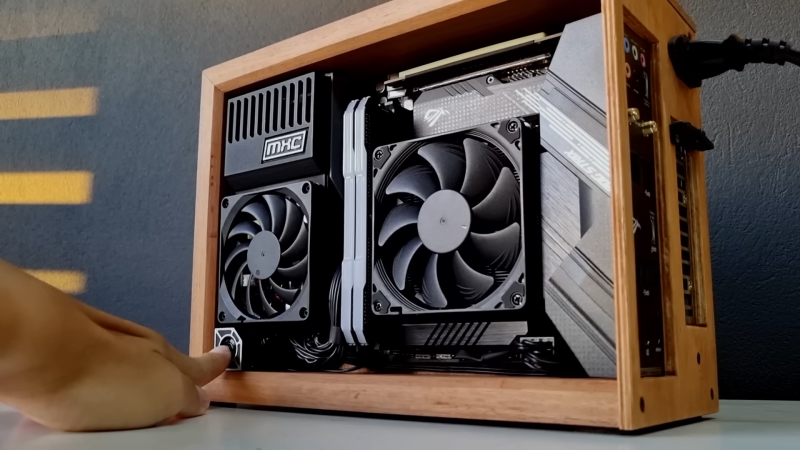Computer cases have come a long way from the ugly beige boxes of the early 2000s. Still, if it was going to sit on his desk, [MXC Builds] wanted something with a little more class. His custom Ironbark ITX PC seems to fit the aesthetic nicely.
The case’s outer shell is ironbark wood cut at 45 degrees and joined for a beautiful waterfall edge (the wood grain seems to flow uninterrupted). The power supply was heavily modified to take a thinner but larger fan, and a new cover and intake grill were 3D printed. As there were no mounting holes on the bottom of the power supply, he printed a bracket with spring clips to hold the PSU securely. Next, he routed a PCI riser cable to the other side of the internal panel so the GPU could mount on the back. He cut custom cables to match up the lengths needed for every run. Finally, rather than placing the power button on the front or top, it was on the side in a custom bracket.
It’s an absolutely gorgeous build that packs some respectable hardware in a tiny space (7.9 L or ~482 in3). The use of 3D printed parts and careful planning results in an incredibly tidy computer that most would proudly display on their desk. It is an open-air case, and if you’re looking for something a little more enclosed, perhaps this mid-century PC might whet your appetite.
















Mitred. The expression you need is “mitred”.
Beautiful bit of kit!
Not impressed with the backside.. but its a nice waiting for the case Hack.
Yeah, the plywood back is a bit of a letdown, but the rest is nice understated design.
I’ve been wanting one of these, but have been concerned that the lack of a metal enclosure would allow RF signals to spill all over the place. Also, I didn’t want my cat to reset the computer when he brushed against it, spilling static onto the parts.
Maybe you could copper plate the cat to disperse static?
I seem to recall about some kind of substance that is safe to apply. Antistaticat?
Vacuum deposition yields a nice conductive surface but does have implementation issues with felines.
Comment v1.0 was platinum sputtering of the cat, like I used to use for EM specimens, but I thought that might not be a familiar enough process for what is, in essence, a silly suggestion and a waste of everyone’s time.
I too have wondered about RF leakage. Does anyone have relevant info on this? Would lining the case with aluminum foil (suitably grounded) work?
I suspect it wouldn’t matter at all for most folk – being no worse than the many other poorly shielded things including other computers out there. The world is full of RF soup these days.
I see no reason foil wouldn’t work, though I’d suggest go a little more up and get copper foil or tape – then its easy to solder to so all the various bits that could use a connection to ground can get one and the foil sides are definitely grounded (not entirely required, but a good idea).
Ordinary metal cases have big enough holes that they don’t really work as faraday cages for any interesting frequencies.
Clip your cat’s tail to an earthing strap
Nice build.
I’ve made a couple myself over the years… ;P
https://smallformfactor.net/forum/threads/farmpc.18103/
https://smallformfactor.net/forum/threads/16l-high-end-sff-case-in-wood-and-aluminium.17400/page-3#post-272328
https://www.guru3d.com/articles-pages/guru3d-rig-of-the-month-july-2020,1.html
https://www.guru3d.com/articles-pages/guru3d-rig-of-the-month-march-2020,1.html
Another wooden PC case, albeit vintage inspired. https://dovetailsandstitches.com/wooden-pc-case/